In our country, where winter lasts six months, we need a good and convenient heating system that would warm the house in any bad weather. Water heating remains the most reliable means of fighting for warmth and comfort in a private house.
Scheme of the operation of the water heating system.
Boilers for various types of fuel and even an ordinary stove are used as heating devices. Where hot water heating uses a stove, the bore diameter of the pipes is increased, and shut-off valves are minimized.
Principle of operation
This system has gained popularity for its simplicity. Heating uses the following principle of operation: the boiler heats water (or antifreeze) to the desired temperature, it flows through pipes to the batteries or radiators in the rooms, giving off heat, and returns to the boiler.
![]()
Scheme of a system with gravity flow of water.
Also, a hot water heating scheme may include:
- expansion tank - excess water generated during heating is discharged into it, and it also ensures the absence of oxygen in the system;
- maintains a constant circulation of water in the system, with its help the speed of heating the room increases due to the faster movement of water;
- pressure gauge;
- thermostats;
- air vent - automatic or shut-off;
- safety valves.
Boiler selection
When buying a boiler, as a rule, they take the value of 1 kW of power per 10 sq. m of heated living space, given that the ceiling height is no more than 3 meters. They also take into account the volume of the room, the degree of insulation of a private house, the size of the windows, the presence of additional heat consumers.
With a heated area: from 60 to 200 sq. m - boiler power up to 25 kW, from 200 to 300 sq. m - 25-35 kW, from 300 to 600 sq. m - 35-60 kW, from 600 to 1200 sq. m - up to 100 kW.
You can choose an electric boiler - with a private house area from 30 to 1000 sq. m, you can use boilers with a capacity of 3 to 105 kW, respectively. The disadvantages of electric boilers are the high cost of electricity, power outages or insufficient power.
The nuances of functioning
When using a stove, to improve the operation of the system, the difference between the lower point of cold water (return) and the upper point of hot water is maximized. The riser is brought out to the ceiling. In any case, the calculation of water heating is carried out. If a heating boiler is used, it is recommended to lower it lower, if possible, for example, into the basement. This arrangement allows you to increase the height of the riser, give the water a greater impulse to move. Consequently, the efficiency will increase, the house will be warmed up more evenly.
Fuel
Different types of fuel are used to heat up the boiler: natural gas, coal, firewood. A centralized power supply can also be used, or alternative energy sources such as mini-hydroelectric power stations, solar or wind converters.
Choice of pipes
When installing water heating, pipes from different materials are used. Each has its own pros and cons.
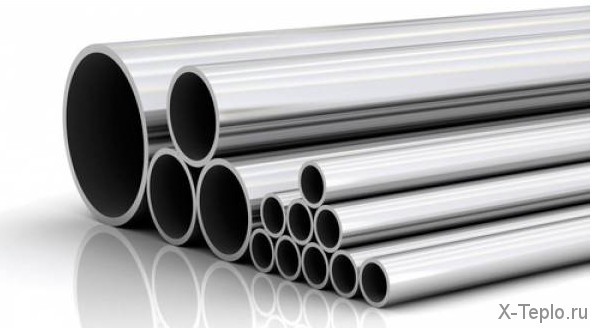
Steel
Steel pipes were previously the most popular, but are used less and less in modern construction. The disadvantage of conventional steel pipes is their susceptibility to corrosion, therefore stainless or galvanized ones are used, which are more reliable.
Copper
Copper pipes withstand high temperatures and pressure, will serve for more than one generation, are the most reliable for use in a private house. Their only drawback is their high cost.
Polymer
Polymer pipes are made from metal-plastic (plastic-coated aluminum) or from polypropylene, reinforced with aluminum.
Main advantages:
- corrosion resistance;
- strength;
- no sediment is deposited on the inner surface;
- low cost of installation work, because welding is not required.
Among the disadvantages is a high coefficient of thermal expansion; in a cold period, a temporary shutdown of the boiler or freezing of the heating system can lead to damage to the pipes.
System design
The single-circuit system is intended only for heating the room. This heating scheme has a simple principle of operation, is inexpensive and is suitable for houses with an area of up to 100 sq. m. Includes atmospheric hood, one-pipe piping made of steel or polymer materials, as well as cast iron, aluminum or steel radiators.
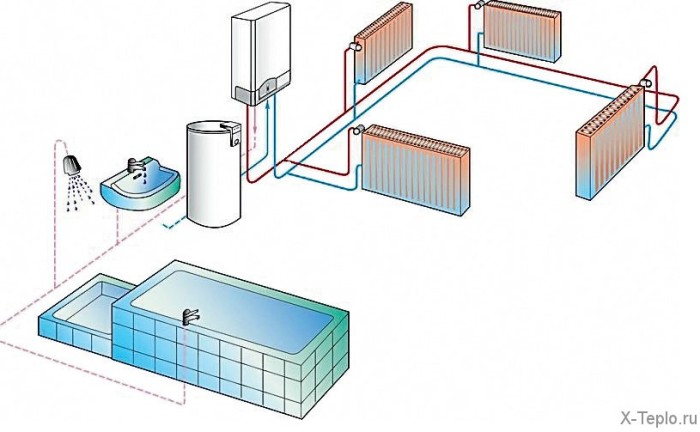
Single-circuit room heating scheme.
This system can be improved by adding two-pipe wiring, a circulation pump, thermostatic valves on radiators. With a single-circuit boiler for supplying hot water for domestic needs, it is necessary to provide for the installation of a gas water heater or boiler. The two-circuit system is used for both residential heating and water heating.
Dual-circuit system
A double-circuit boiler is convenient for hot water needs for a family of no more than four people, and taking into account that tap water or softened water (hard water from a well is not suitable). Also, two single-circuit systems can be made, one of them will heat the room, the other will heat the water. This will allow in summer to use only the water heating system, which consumes 25% of the boiler's capacity.
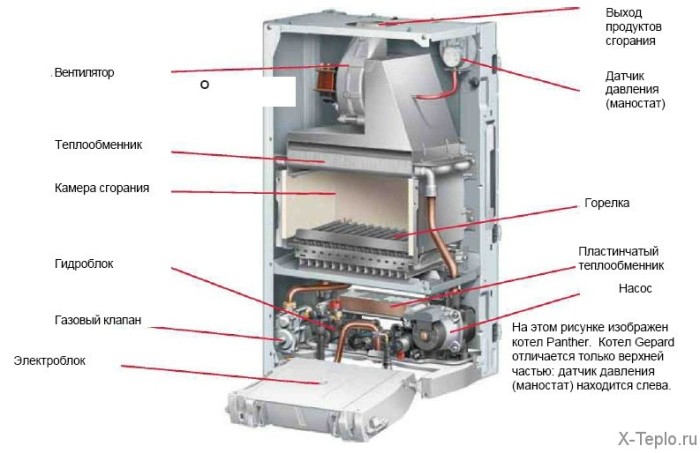
The device is a double-circuit boiler.
The most common classification of hot water heating systems takes into account the piping layout. Water heating can be either two-pipe or one-pipe.
One-pipe heating system
A single-pipe system is called a system in which heated water from the boiler sequentially passes from one battery to the next. As a result, the last battery will be colder than the first, as a rule, such a system is used in apartment buildings. The most significant drawback is that it is difficult to manage a one-pipe wiring, because if you block the access of water to one of the radiators, then all the others will overlap.
Two-pipe heating system
In a two-pipe radiator, a pipe with hot and cold water is suitable for each radiator. Water heating of a private house allows you to comfortably regulate the temperature in the rooms.
Collector (beam) - from the collector (a device in the heating system that collects the coolant), two pipes are supplied to each heating device - a straight line and a return line. This makes it easy to install heating systems with hidden pipe wiring, and also makes it possible to maintain and regulate the set temperature in a separate room. To do this, on each floor of the house, collectors are located in a special cabinet, from which independently connected pipes go to the radiators. The disadvantages are the costs of pipes and installation of manifold cabinets.
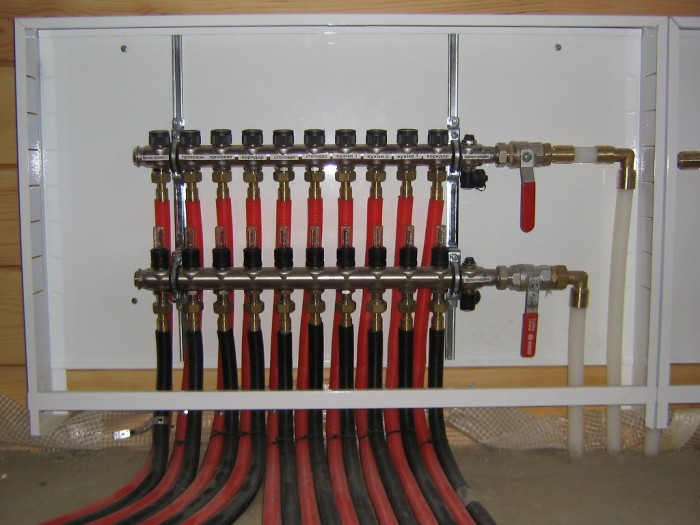
Pumps
In addition, when laying heating pipelines for a country house, circulation pumps are installed - they do an excellent job of circulating water in large houses with a long length of pipes, save fuel consumption, and also heat up the room faster due to the rapid movement of water.
Experts recommend making a scheme with vertical risers and two-pipe wiring for one-story houses with a steep roof, as well as a basement. When installing a water one, it is important to think about where the exhaust gases will go. To ensure their exit, you need to install a special pipe.
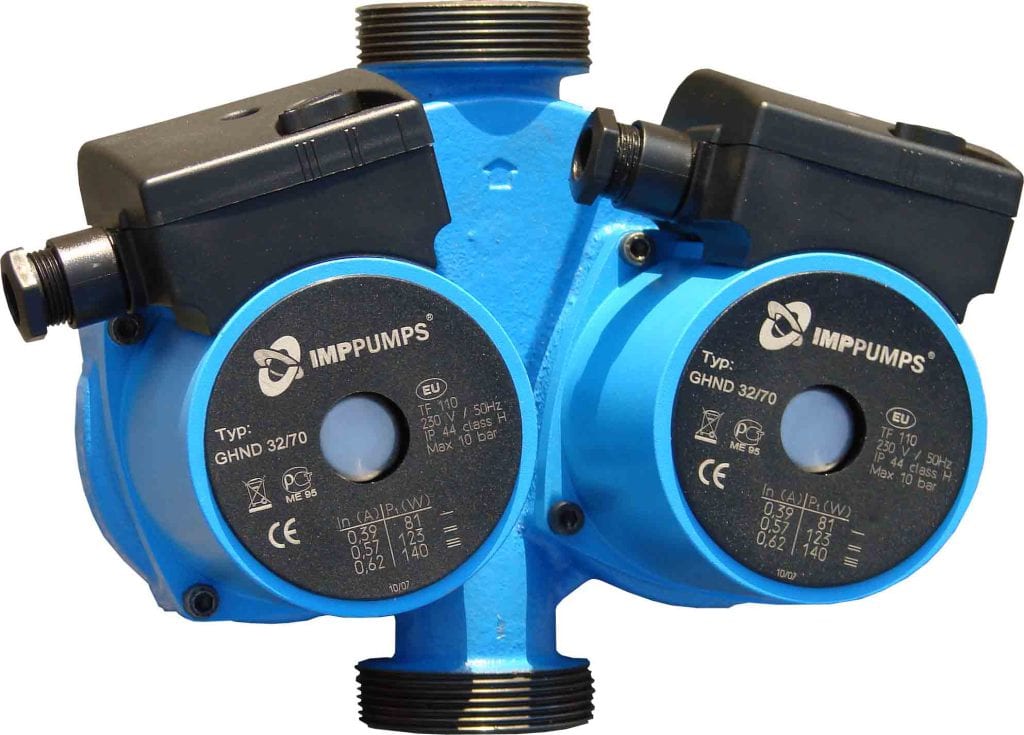
Calculation of water heating
First, you need to calculate the system. First of all, it must be remembered that the need for heating will directly depend on factors such as heat loss through window and door openings, as well as through walls, floors and ceilings. Thus, in order to calculate the power, you need to know the principle of the system and the degree of heat loss by the finishing and construction materials from which the house is made.
The walls of a private house that are in direct contact with the external atmosphere conduct heat more efficiently. In this case, the degree of heat loss will increase with each temperature difference between the inner and outer sides of the wall. The normal temperature is 20 ° C.
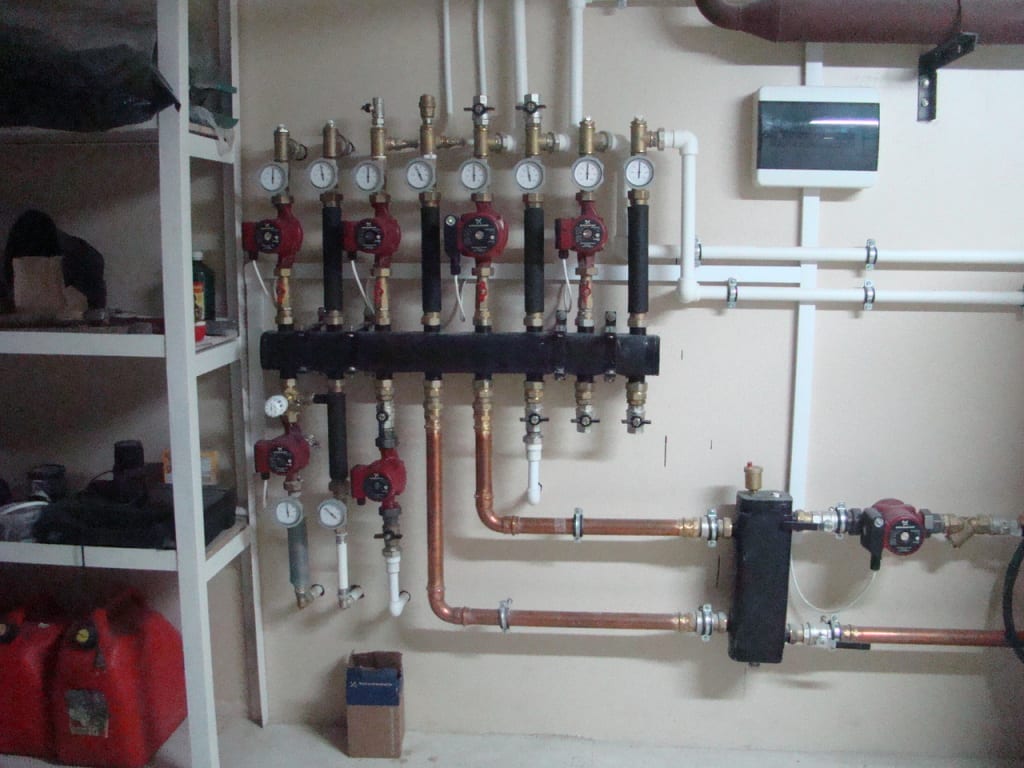
When calculating hot water heating, this indicator should be summed up with the highest negative temperature typical for a particular area. When calculating heat loss, you need to calculate the exact area of the end (external) walls, door and window openings, ceilings, floors, and then multiply this data by the degree of heat loss on each square meter of a private house. After that, all the results are summed up.
The correct calculation of the location of the distribution boiler is very important, since the number of bends and the length of the sections of the heating system of the living quarters in a private house will directly depend on this.
Installation features
Before you start equipping water heating with your own hands, it is worth considering the most popular and practical systems, advantages and disadvantages, installation principles, as well as suitable types of radiators. 
Self-made construction of a house is always associated with the organization of space heating. This question is being considered long before the start of the relevant work. There are many options. They are considered by any person who is going to provide heating of a country house with his own hands. Quite often there are cases when no one can help with advice. The company's specialists charge a fee for this, which makes their services not the most profitable option. You have to think through everything yourself.
Nuances and subtleties
Those who have a desire to make homemade heating should remember that only those types of pipes should be used that have a small diameter, since only they can maintain a high water temperature and effectively create and maintain the required temperature regime in the Russian climate.
However, they also have their drawbacks. In particular, the installation of hot water heating, due to the small diameter of the pipes, cannot be carried out without preliminary overhaul of the entire room. In addition, as for the water heating system itself, it requires constant heating of the coolant.

Therefore, if you forgot to drain the water from the pipes of your private house in the winter season and left it for a long time, then you should expect trouble, because the pipes can simply break under the influence of low temperatures. As a result, upon your return, you will be forced to repair the entire water heating system, since the main part of the pipeline will be damaged.
But even if you do not forget to drain water from heating pipes with a small diameter, they can still suffer from the effects of corrosion, since the presence of air will take place, which will lead to the formation of internal condensation on the walls of the pipeline.
Water heating of a country house is an affordable cost of materials for installation and further operation, as well as good results in creating warmth and comfort in the house.



